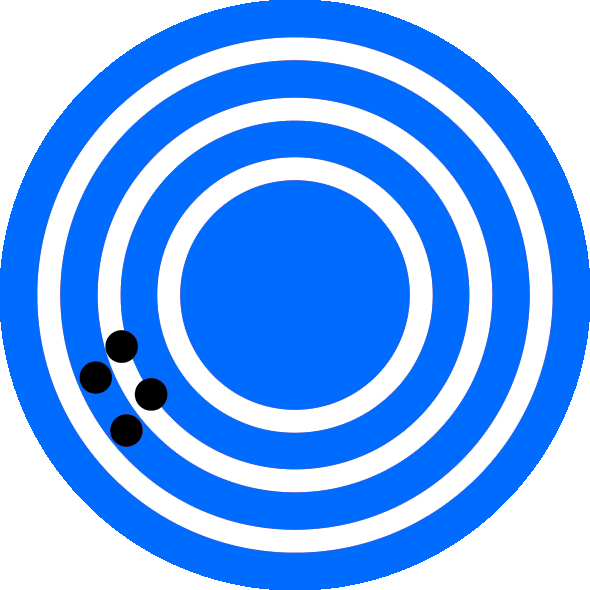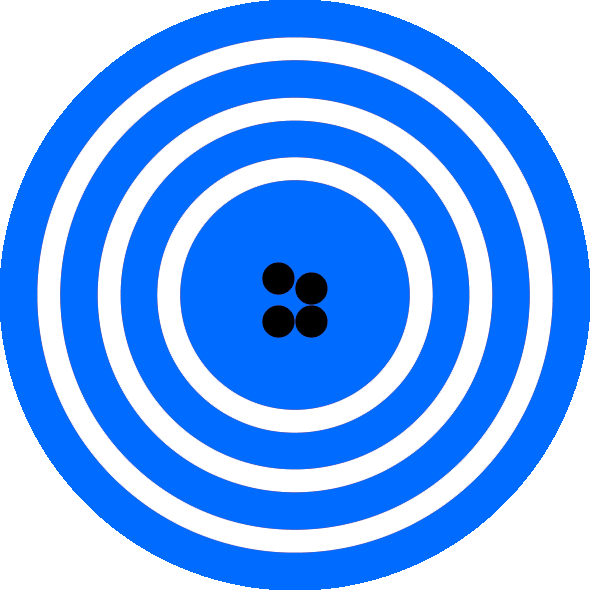
Let’s talk about accuracy and precision for a moment.
To start, shown above is an example of high accuracy but low precision. The marks on the target are close to the central bullseye, but not close to each other.
Accuracy often refers to how close something is to its true or expected value. Let’s say that you aim to drill a 1/4″ hole. If the final result is a 0.2500″ hole, than you have achieved high accuracy.
Precision often refers to how repeatable something is.
Ideally, you want high accuracy and precision.
Let’s say that you aim to drill (5) 1/4″ holes. If your holes are 3x 0.27″, 1x 0.265″, and 1x 0.275″, you have achieved good precision.
There are times when you can get away with prioritizing precision over accuracy. Do your workbench legs need to be exactly 34″ tall, or can they be 34-1/8″?
But other times, dimensions are more critical. If your cabinet opening is exactly 24″, your drawer slides will require the drawers to be a specific width, with just a little leeway. If the opening is less accurate than you anticipated, it will affect the size you need to build your drawers to.

Here, this one’s an example of high precision but low accuracy. The marks are close to each other, but further away from the bullseye.
Which is more desirable? With high precision and low accuracy, each value will be off by a similar amount. With high accuracy and low precision, each value is closer to the true or expected value, but repeatability suffers. Things can sometimes average out.

So here, this is high accuracy and high precision.
This is the goal. But realistically, it takes skill, practice, and sometimes even talent.
Talking about 1/4″ holes again, you might consider two parts of a measurement, the nominal measurement and the tolerance: 0.250″ ±0.001″. Getting close to that 0.250″ size is related to accuracy, and getting multiple measurements within a certain window relates to precision. What this means is that you want your measurements to be within 0.249″ and 0.251″.
At times, that first nominal value can be more flexible. It might not be critical to change a certain dimension, either deliberately or through an unforeseen repeated error, such as not taking into account the exact kerf thickness of a saw blade. But that second value – if you mess up and achieve low precision, your work might look crooked, sloppy, or loose.

Here’s a rectangle where there is a small difference between opposite sides. The target is 400px for the horizontal edges, and 350px for the verticals.

That bottom right hand corner reflects small errors, but compound to create a noticeable gap.

If you don’t notice or correct for the error, and attach everything together, your corners won’t quite be square.
With higher precision, maybe the horizontal components end up being 395 units, and the verticals both 345 units. That might still work.
But if you have a 400 x 350 unit space to fill, you might need higher accuracy and precision.
Let’s say you need two holes, one through the top of a box, one through the bottom. Your holes end up being spot-on in diameter – 0.255″ to friction-fit a 0.250″ shaft. But you’re not accurate enough. The hole in the top was placed 0.1″ to the right of where it was desired, and the hole in the bottom was placed 0.1″ to the left.

IF your shaft fits, there will be a misalignment. If the top and bottom materials are thicker, then your shaft might not fit at all.
It’s not necessary to obsess over accuracy and precision. Well…
But it’s at least a good idea to keep it in mind. It’s hard to know what you can get away with, and which aspects of a project need to be better controlled. Sometimes things become obvious mid-way through a project, or worse – at the end. It’s usually far easier to get things right at the start, than to have to correct things afterwards.
There’s an adage – measure twice, cut once. That’s not always enough.
Unfortunately, there’s no clear cut answer about how to get better at achieving high accuracy and precision. My first 2×4 workbench was an absolute disaster. It was crooked, and wobbly, and I couldn’t for the life of me figure out what I was doing wrong. Well, I built it on the floor, starting with the top, not knowing that the floor wasn’t flat.
I’m sure I’m not the only one who forgot to account for saw blade kerf thickness when making a cut. Cutting a 36″ board in half doesn’t give you two 18″ boards. Especially not if you’re a poor student with no power tools but a drill and Dremel, and who trusted the worker at the home center to cut several boards to accurate sizing at the store.
Achieving high accuracy or high precision, or even better yet – high accuracy and precision – takes a combination of tools, skills, and experience. Even then, nobody is perfect.